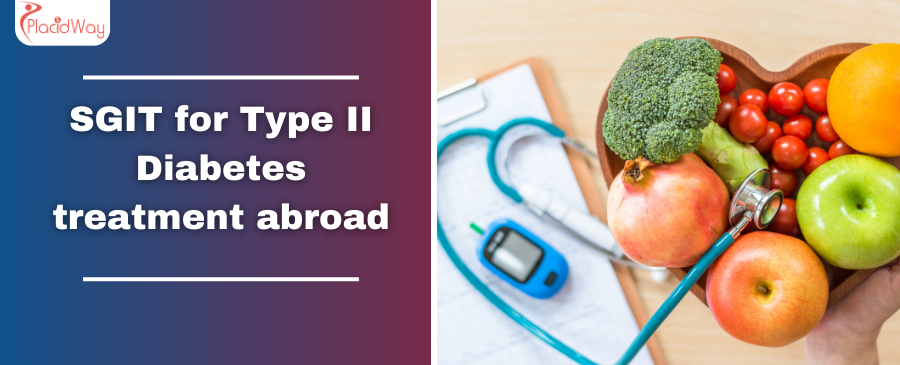
Unlocking New Hope: Understanding SGIT for Type II Diabetes Management
Living with Type II Diabetes can be a relentless battle, often requiring strict diet, exercise, and a regimen of medications, including insulin. For many, maintaining optimal blood sugar control remains a significant challenge, leading to long-term complications that impact quality of life. If you're searching for "new diabetes treatments" or "non-surgical options for Type II Diabetes," you're not alone. The search for more effective and sustainable solutions is paramount for countless individuals worldwide.
Enter SGIT, or Stomach Ghrelin Inhibition Therapy – a groundbreaking, minimally invasive procedure offering a ray of hope for those struggling to manage their Type II Diabetes. This innovative treatment doesn't involve traditional surgery but instead uses an endoscopic approach to help improve insulin sensitivity and glucose metabolism. It’s a promising avenue for patients who might not be candidates for bariatric surgery or have found conventional diabetes management insufficient.
But what exactly is SGIT, and how does it work? Who can benefit from it? This comprehensive guide will delve deep into this revolutionary procedure, exploring not just the "causes of Type II Diabetes" and its debilitating "symptoms," but also how SGIT can offer a path toward better health. We'll cover everything from eligibility and recovery to worldwide costs and why "diabetes treatment abroad" through medical tourism might be an excellent option for you. Our goal is to provide clarity, empathy, and practical information, drawing from real patient search intent to address your most pressing questions.
What are the common symptoms of Type II Diabetes?
Recognizing the "early signs of diabetes" is crucial for timely diagnosis and management. Unlike Type I, Type II Diabetes symptoms often develop slowly, sometimes over years, and can be so subtle that they go unnoticed. Many people don't realize they have the condition until complications arise. Here are the most common symptoms to be aware of:
- Increased Thirst (Polydipsia) and Frequent Urination (Polyuria): Excess sugar building up in your blood pulls fluid from your tissues. This makes you thirsty, and as you drink more, you urinate more to flush out the sugar.
- Increased Hunger (Polyphagia): Despite eating, your body's cells aren't getting enough energy due to insulin resistance, leading to constant hunger.
- Fatigue: When your cells can't access glucose for energy, you may feel tired and sluggish, regardless of how much you rest.
- Blurred Vision: High blood sugar levels can affect the small blood vessels in your eyes, causing blurry vision. If untreated, it can lead to more serious eye problems.
- Slow-Healing Sores or Frequent Infections: High glucose levels can impair your body’s natural healing process and weaken your immune system, making you more susceptible to infections, especially skin and urinary tract infections.
- Unexplained Weight Loss or Gain: While weight gain is more common with Type II, some might experience unexpected weight loss if their body is breaking down muscle and fat for energy due to glucose not entering cells.
- Tingling or Numbness in Hands or Feet: Nerve damage (neuropathy) due to prolonged high blood sugar can cause these sensations.
- Darkened Skin Patches: Often found in the armpits and neck, a condition called acanthosis nigricans can signal insulin resistance.
If you experience any of these symptoms, especially if they persist, it’s essential to consult a doctor to determine "how to know if you have diabetes" and get tested.
What causes Type II Diabetes and what are its risk factors?
Understanding "why do people get Type II Diabetes" involves recognizing a complex interplay of genetic and environmental factors. At its core, Type II Diabetes is characterized by two main problems:
- Insulin Resistance: Your muscle, fat, and liver cells stop responding well to insulin, preventing glucose from entering the cells for energy.
- Insufficient Insulin Production: The pancreas, initially working overtime to compensate for insulin resistance, eventually wears out and can't produce enough insulin to keep blood glucose levels normal.
Several "diabetes risk factors" significantly increase your likelihood of developing Type II Diabetes:
- Obesity and Overweight: Being overweight or obese is the strongest risk factor. Excess fat, especially around the abdomen, makes cells more resistant to insulin.
- Physical Inactivity: A sedentary lifestyle contributes to insulin resistance. Physical activity helps your cells respond better to insulin and uses glucose for energy.
- Unhealthy Diet: Diets high in processed foods, sugary drinks, and unhealthy fats can lead to weight gain and insulin resistance.
- Genetics and Family History: If a parent or sibling has Type II Diabetes, your risk is higher.
- Age: The risk increases as you get older, typically after age 45, though it's increasingly seen in younger individuals.
- Race and Ethnicity: Certain ethnic groups (African Americans, Hispanic/Latino Americans, American Indians, Asian Americans, Pacific Islanders) have a higher risk.
- Gestational Diabetes History: Women who developed diabetes during pregnancy are at higher risk later in life.
- Polycystic Ovary Syndrome (PCOS): Women with PCOS are at an increased risk due to insulin resistance.
- High Blood Pressure and High Cholesterol: These conditions are often linked to insulin resistance and increase diabetes risk.
While some risk factors like genetics are unchangeable, many others, such as diet and exercise, can be managed to significantly reduce your risk.
What is SGIT (Stomach Ghrelin Inhibition Therapy) and how does it treat Type II Diabetes?
SGIT stands for Stomach Ghrelin Inhibition Therapy, and it represents a fascinating frontier in the "new diabetes therapy" landscape. It's a "non-surgical diabetes treatment" that focuses on a key hormone called ghrelin, often dubbed the "hunger hormone." Ghrelin is primarily produced in the fundus region of the stomach and plays a significant role not just in appetite regulation but also in glucose metabolism and insulin sensitivity.
Here’s "how SGIT works" to help manage Type II Diabetes:
- Minimally Invasive Endoscopic Procedure: Unlike traditional surgery, SGIT is performed endoscopically. A thin, flexible tube with a camera (endoscope) is guided through the mouth, esophagus, and into the stomach.
- Targeted Injection: Once inside the stomach, a specialized solution (often a non-absorbable polymer or a thermal ablation technique) is precisely injected into the mucosal lining of the stomach fundus. This area contains the cells responsible for producing ghrelin.
- Ghrelin Reduction: The injection aims to reduce the functionality or number of ghrelin-producing cells. This decrease in ghrelin levels has several beneficial effects:
- Reduced Appetite: Patients often experience a significant reduction in hunger and increased satiety, leading to reduced caloric intake and weight loss.
- Improved Insulin Sensitivity: Lower ghrelin levels are associated with enhanced insulin sensitivity. This means your body’s cells respond more effectively to the insulin produced, allowing glucose to enter cells more efficiently.
- Better Glucose Metabolism: The overall metabolic changes contribute to more stable blood sugar levels, reducing hyperglycemia.
- Impact on Type II Diabetes: By improving insulin sensitivity and helping with weight loss (a major factor in Type II Diabetes), SGIT can lead to better glycemic control. For some patients, this might mean a reduction in diabetes medication, including insulin, or even achieving partial or complete remission.
SGIT offers a novel approach that addresses both the appetite-related and metabolic aspects of Type II Diabetes, providing a potential long-term solution without the complexities of major surgery.
Who is eligible for SGIT to manage Type II Diabetes?
Determining "am I a candidate for SGIT" involves a thorough evaluation by a multidisciplinary medical team. SGIT is not for everyone with Type II Diabetes, and specific criteria are used to identify individuals most likely to benefit. While exact criteria can vary between clinics and research protocols, general guidelines often include:
- Diagnosis of Type II Diabetes: Patients must have a confirmed diagnosis of Type II Diabetes.
- Suboptimal Glycemic Control: This procedure is usually considered for individuals who have struggled to achieve adequate blood sugar control (e.g., HbA1c above 7.0%) despite consistent efforts with diet, exercise, and standard diabetes medications.
- Body Mass Index (BMI): While traditional bariatric surgery is typically for BMIs over 35-40, SGIT may be an option for individuals with lower BMIs, often in the range of 27-35 kg/m², who are overweight or mildly obese with diabetes. Some protocols may extend to higher BMIs as well.
- Insulin Resistance and Pancreatic Function: Assessments of C-peptide levels and insulin resistance help determine if the patient's pancreas still has sufficient function to benefit from improved insulin sensitivity.
- Commitment to Lifestyle Changes: Candidates must be motivated to adopt and maintain necessary dietary and lifestyle modifications post-procedure.
- Absence of Contraindications: Certain medical conditions may make SGIT unsuitable, including:
- Severe cardiovascular, renal, or hepatic disease.
- Active inflammatory bowel disease or severe gastrointestinal conditions.
- Bleeding disorders.
- Active cancer.
- Pregnancy or breastfeeding.
- Uncontrolled psychiatric disorders.
A comprehensive assessment will involve detailed medical history, physical examination, blood tests (including HbA1c, C-peptide, lipid profile), and sometimes endoscopic evaluation. Your healthcare team will discuss if you "qualify for SGIT" and if it aligns with your health goals.
What can I expect during recovery after SGIT for Type II Diabetes?
One of the advantages of SGIT as a minimally invasive procedure is its relatively quick "SGIT recovery time" compared to traditional surgery. However, understanding "what to expect after SGIT" is vital for a smooth recovery and optimal results.
- Immediate Post-Procedure: You will typically spend a few hours in a recovery room. Most patients can be discharged the same day or stay overnight for observation, depending on the clinic's protocol and individual response.
- Initial Discomfort: It's common to experience some mild to moderate abdominal pain, cramping, nausea, or a feeling of fullness/bloating for a few days. These symptoms are usually manageable with prescribed pain medication and anti-nausea drugs.
- Dietary Progression: A strict post-SGIT diet plan is crucial. It typically follows these stages:
- Days 1-7: Clear liquids, then full liquids (broth, protein shakes, thin soups).
- Weeks 2-3: Pureed or soft foods (yogurt, mashed potatoes, well-cooked vegetables, soft scrambled eggs).
- Weeks 4+: Gradually reintroduce solid foods, focusing on lean protein and non-starchy vegetables, chewing thoroughly.
Hydration is vital, but avoid drinking large quantities rapidly or with meals.
- Return to Activities: Most patients can resume light daily activities within 2-3 days. Strenuous exercise, heavy lifting, or intense physical work should be avoided for a few weeks, as advised by your doctor.
- Follow-up Appointments: Regular follow-up appointments are essential for monitoring your blood sugar levels, adjusting diabetes medications (often dosages can be reduced quickly), and providing nutritional guidance. This phase is critical for achieving long-term success.
- Lifestyle Adjustments: SGIT is a tool, not a magic bullet. Sustained success requires ongoing commitment to a healthy diet and regular physical activity.
"Life after SGIT" means embracing a healthier lifestyle, supported by the metabolic benefits of the procedure.
What are the potential risks and side effects of SGIT for Type II Diabetes?
Like any medical procedure, SGIT carries potential "SGIT side effects" and risks, though it's generally considered safe due to its minimally invasive nature. It’s important to discuss these thoroughly with your medical team before proceeding. Here's what to know about "is SGIT safe" and its potential complications:
Common, Temporary Side Effects:
- Nausea and Vomiting: These are the most frequently reported side effects in the days immediately following the procedure, often due to stomach irritation. They are typically managed with anti-emetic medications.
- Abdominal Pain or Discomfort: Mild to moderate pain or cramping in the stomach area is normal and usually subsides within a few days.
- Bloating and Indigestion: A feeling of fullness or difficulty digesting certain foods temporarily may occur.
- Acid Reflux or Heartburn: Some patients may experience a temporary increase in reflux symptoms.
Less Common or Rare Serious Risks:
- Bleeding: As with any endoscopic procedure involving injection, there's a small risk of bleeding at the injection site. This is usually mild and self-limiting but can occasionally require intervention.
- Infection: Although sterile techniques are used, there's a minimal risk of infection.
- Perforation: An extremely rare but serious complication where the endoscope or injection causes a puncture in the stomach wall. This would require emergency surgical repair.
- Adverse Reaction to Anesthesia: Risks associated with general anesthesia are present, as with any procedure requiring it.
- Failure to Achieve Desired Results: While SGIT is promising, it may not produce the same level of blood sugar control or weight loss for all individuals.
- Long-term Effects: As a relatively new procedure, the full long-term effects and durability of SGIT are still being studied, though initial results are very positive.
Your doctor will conduct a thorough evaluation and discuss all potential risks versus benefits, ensuring you make an informed decision about the "risks of stomach injection for diabetes" and SGIT.
How much does SGIT for Type II Diabetes cost worldwide?
For many patients, the "SGIT price" is a significant factor in their decision-making, especially when considering "affordable diabetes treatment abroad." The cost of SGIT for Type II Diabetes can vary dramatically from one country to another, influenced by healthcare infrastructure, economic factors, and the specific services included in the treatment package. Here’s a general overview of worldwide costs:
SGIT for Type II Diabetes Cost Comparison Table (Estimated)
| Region/Country | Estimated Cost Range (USD) | Notes |
|---|---|---|
| USA / Western Europe | $18,000 - $25,000+ | Highest costs due to high healthcare expenses and limited insurance coverage for experimental procedures. |
| Mexico / Colombia | $10,000 - $18,000 | Popular for North American patients seeking quality care at significantly lower prices. |
| Turkey / India / Thailand | $8,000 - $15,000 | Leading medical tourism destinations offering excellent facilities and highly competitive pricing. |
| Other Asia / Eastern Europe | $7,000 - $12,000 | Emerging destinations, often with specialized clinics and lower living costs. |
These figures are estimates and can fluctuate based on:
- Clinic Reputation and Location: Premier clinics in major cities often charge more.
- Surgeon's Expertise: Highly experienced surgeons may have higher fees.
- Inclusions: Some packages cover pre-procedure diagnostics, hospital stay, post-op medications, and follow-up consultations, while others only cover the procedure itself.
- Length of Stay: Extended hospital or recovery stays will add to the overall cost.
- Currency Exchange Rates: Can impact the final price for international patients.
When comparing costs, always request a detailed quote that outlines all inclusions to avoid unexpected expenses.
Why should I consider SGIT for Type II Diabetes treatment abroad?
The decision to seek "diabetes treatment overseas" is often driven by compelling reasons, especially for advanced procedures like SGIT. Medical tourism for Type II Diabetes offers several distinct advantages:
- Cost-Effectiveness: This is arguably the primary driver. As seen in the cost table, the price for SGIT in many countries can be a fraction of what it costs in regions like North America or Western Europe, making cutting-edge treatment accessible.
- Access to Advanced Treatments and Expertise: SGIT is still relatively new in some regions. Certain countries or clinics abroad may have more experience, specialized equipment, or be pioneers in offering this specific procedure, providing access to care that might not be readily available or approved in your home country.
- Reduced Waiting Times: In countries with universal healthcare systems, long waiting lists for specialized procedures can be a frustration. Traveling abroad can significantly expedite your treatment schedule.
- High-Quality Care and Facilities: Many leading medical tourism destinations boast state-of-the-art hospitals, internationally accredited facilities (like JCI-accredited hospitals), and highly skilled, often internationally trained, medical professionals. Quality is not sacrificed for cost.
- Privacy and Anonymity: For some, the privacy of undergoing a medical procedure away from home is appealing.
- Opportunity for Travel and Recovery: Combining your treatment with a vacation or a period of recovery in a new, relaxing environment can be an added benefit, often referred to as "medical tourism."
For those seeking advanced care for Type II Diabetes without the prohibitive costs or lengthy waits, "medical tourism for diabetes" presents a viable and increasingly popular alternative.
Which countries are known for providing SGIT for Type II Diabetes with good value and quality?
When considering "SGIT abroad destinations" or "best countries for diabetes surgery," several nations consistently rise to the top for their combination of quality medical care and competitive pricing. These countries have invested heavily in their medical tourism infrastructure and attract patients globally:
- Turkey: Known for its modern hospitals, English-speaking medical staff, and highly skilled surgeons, especially in bariatric and metabolic procedures. Istanbul and Ankara are hubs for medical tourism, offering excellent facilities and competitive prices.
- Mexico: A prime destination for North American patients due to proximity. Cities like Tijuana, Cancun, and Guadalajara offer reputable clinics with experienced specialists, often at a fraction of US costs.
- India: A powerhouse in medical tourism, renowned for its highly qualified doctors, world-class hospitals, and extremely cost-effective treatments. India has a long history of medical excellence, particularly in complex surgical procedures.
- Thailand: Famous for its hospitality and advanced private hospitals. Bangkok and Phuket are popular destinations, offering luxurious medical facilities, attentive care, and a holistic recovery experience.
- Colombia: An emerging destination, particularly for procedures in Latin America. Cities like Bogotá and Medellín are gaining recognition for quality medical care, skilled surgeons, and more accessible pricing.
When researching "top clinics for SGIT" in these countries, always look for international accreditations (like Joint Commission International - JCI), surgeon credentials, and positive patient testimonials to ensure both quality and safety.
What should I expect when traveling abroad for SGIT and how can I ensure its safety and quality?
Embarking on a "medical trip overseas" for SGIT requires careful planning and a clear understanding of what to expect to ensure a safe and successful journey. Here's a breakdown of the process and how to ensure the highest standards of care:
What to Expect When Traveling for SGIT Abroad:
- Initial Consultation & Planning: Most clinics offer virtual consultations. You'll discuss your medical history, eligibility, and receive a preliminary treatment plan and cost estimate. Medical tourism facilitators like PlacidWay can help streamline this process, connecting you with vetted clinics.
- Travel & Accommodation: You'll need to arrange flights, visas (if necessary), and accommodation. Many international hospitals have partnerships with nearby hotels or offer concierge services to assist.
- Pre-Procedure Assessments: Upon arrival, you'll undergo thorough in-person evaluations, including physical exams, blood tests, and potentially further diagnostic imaging to confirm eligibility and tailor your treatment plan.
- The SGIT Procedure: The procedure itself is typically quick (1-2 hours) and performed under sedation or general anesthesia.
- Hospital Stay & Recovery: You might stay for a few hours or overnight for observation. Your total stay in the destination country may range from 5-10 days, allowing for initial recovery and follow-up checks before traveling home.
- Post-Procedure Support: The clinic will provide detailed instructions for diet, medication, and activity. They should also outline a plan for follow-up care once you return home, often involving communication with your local doctor.
How to Ensure Safety and Quality Abroad:
Navigating "safe SGIT abroad" options requires diligence. Here are key steps:
- Choose Accredited Facilities: Look for international accreditations such as Joint Commission International (JCI), which signifies adherence to rigorous global standards for patient safety and quality of care.
- Verify Surgeon Credentials: Research the surgeon's experience, certifications, and specialization in endoscopic or metabolic procedures. Check their professional affiliations and read patient reviews.
- Examine Facility Standards: Ensure the clinic has modern equipment, adheres to strict hygiene protocols, and maintains appropriate patient-to-staff ratios. Ask for virtual tours or photos.
- Utilize Reputable Medical Tourism Facilitators: Companies like PlacidWay specialize in connecting patients with high-quality, vetted medical providers abroad. They assist with communication, logistics, and can provide unbiased information, significantly reducing risks.
- Clear Communication: Ensure there are clear communication channels with your medical team, especially regarding language barriers. Many international clinics have English-speaking staff or dedicated interpreters.
- Understand the Full Package: Get a detailed quote outlining all costs, inclusions, and exclusions (e.g., flights, accommodation, specific medications, long-term follow-up).
- Plan for Post-Op Care: Discuss how your local doctor will coordinate with the overseas clinic for ongoing monitoring and support after you return home.
By taking these steps, you can confidently explore "medical travel tips for diabetes" and ensure a high-quality, safe SGIT experience abroad.
Take the Next Step with PlacidWay
Ready to explore treatment options abroad? Discover top clinics, compare prices, and get a free quote tailored to your needs with PlacidWay.
Alternative Chronic Health Therapies | Best Medical Centers Abroad










Share this listing